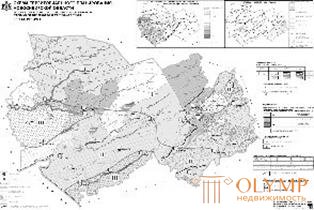
Definition: urban planning system - a set of spatially organized and interrelated material elements - technically developed territories, buildings and structures, roads and engineering structures, together with the natural components that form the living environment of society at different territorial (scale) levels.
Territorial levels: settlement system in the territory of the continent, country, region, district (group of districts), agglomeration, city.
The urban planning system is a natural-man-made (natural-anthropogenic) system and actively incorporates natural components.
Any urban planning system is in a state of constant development (progress, regress). The development process is influenced by both external and internal factors. For example, the evolution of cities and the entire settlement system of the West Siberian region was influenced by: climatic conditions, geopolitical and macroeconomic situation, the situation in the general settlement system and the transport communications system, etc.
Territorial conditions and resources directly affect the development of urban planning systems. An important component of urban planning is a comprehensive assessment of the territory (Fig. 38).
Water resources |
Bioresource potential |
Landscape map |
Geotechnical conditions |
Fig. 38. Territorial planning scheme of the Novosibirsk Region. Comprehensive territorial assessment (Central Research Institute of Urban Planning, RAACS, 2006) | |
Resources are divided into natural (minerals, water, forest, etc.) and man-made
(human resources, level of education of the population, engineering and transport infrastructure, industrial and construction base, etc.).
The landscape of the territory and its natural resources largely determine the planning organization of the urban planning system (the geography of mineral deposits determines the position of industrial enterprises, the configuration of the river and the relief affects the distribution of populated areas, etc.). It can be said that the pattern of the emerging urban planning system follows the pattern of the natural landscape.
To describe the processes occurring in urban planning systems, the concepts of frame and fabric are used.
Definition: The framework is a relatively unchangeable, time-stable basis of the spatial planning organization of a city (urban planning, ecological frameworks, see fig. 39, 40).
Urban frame. As applied to the settlement system, these are the main (backbone) transport and communication corridors and major population centers. The zone of influence of such corridors is the most developed and populated. As applied to the city, these are the main axes and nodes of the transport infrastructure with the territories occupied by the most important objects of the city, capital construction.
The urban frame fixes the geometry of the city plan and predetermines the trends of the territorial development of the city.
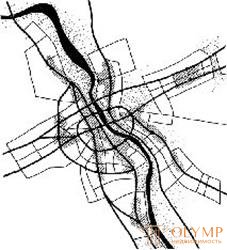
Fig. 39. The framework of the planning structure of a large city.
Definition: fabric or “filling” - areas that are less intensively developed (residential or industrial areas, recreational areas and forests, undeveloped areas). The skeleton develops due to the absorption of tissue.
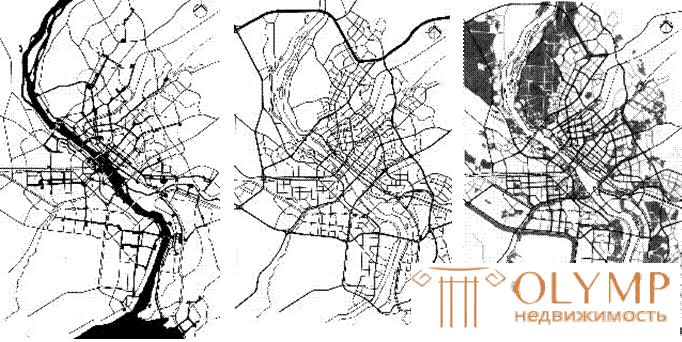
Urban frame Transport frame Ecological frame
Fig. 40. Proposals for the development of Novosibirsk, prof. G.N. Tumanik, 2007
There are three fundamentally different types of urban planning systems (agglomeration level):
Definition: agglomeration - characterized by a high degree of integration of urban functions, continuous development of territories and density of the transport and communication network (Fig. 41).
As a rule, agglomerations are formed on the basis of a large historical city center (Moscow, London, Paris agglomerations).

Fig. 41
Formed the main structural frame of the area of the city center. The form is centric (star-shaped, finger-shaped, octopus tentacles, etc.).
As a rule, stand out:
- agglomeration core - hourly transport accessibility from the center.
- external agglomeration zone - two-hour transport accessibility from the center (Fig. 42).
Within the boundaries of the agglomeration, intense pendulum migration is observed, and as the distance from the center increases, the intensity of movement decreases.
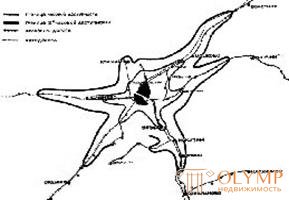
Fig. 42. Novosibirsk agglomeration, boundaries of transport accessibility, 1980s.
Agglomeration
Monocentric
(single core) are a major city center,
surrounded by smaller settlements. Monocentric agglomeration develops as a single organism, in which centripetal tendencies are strong and there is a hierarchical structure of settlements.
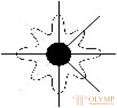
Polycentric
(multicore) are characterized by relatively
independent development of the complex
city centers (-nier), the growth of which leads to their convergence and territorial coalescence.

Definition: a group system of populated areas (group city, group settlement system) is characterized by a clear spatial separation of individual settlements, with developed transport and functional connections, which allows us to consider the group of settlements as an integral urban development (Fig. 43).
In a group system, spatially separated settlements can be compared with areas in a large city, between which intensive population movements are carried out for labor, business, or cultural and everyday purposes.
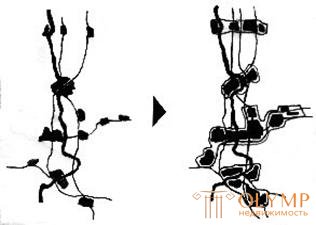
Fig. 43
There is an intensification of inter-settlement links and the formation of a multi-core system of centers of settlement, their integration into the network-type framework. In the future, it is possible to connect to this framework of new elements, the formation of complex strip-strip formations.
Example: Rhine-Ruhr urbanized area in Germany, Kuzbass group cities.
Definition: city associations are territorial entities covering large spaces, relations between settlements are not intensive (population movements with business, cultural and everyday goals prevail).
The association always identifies the city center, which is a stronghold of management and maintenance. The association (area of influence of the city center), as a rule, includes small towns and villages (Fig. 44).
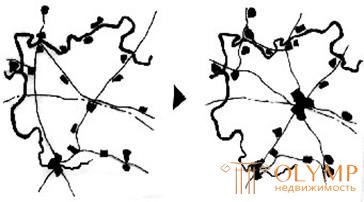
Fig. 44
There is a development of the city center (often the administrative center of the district), the development of transport networks that provide links to this central base station with small settlements dispersed throughout the district.
Example: a mobile settlement system in the area of development of oil and gas fields in Western Siberia.
Что бы оставить комментарий войдите
Комментарии (0)